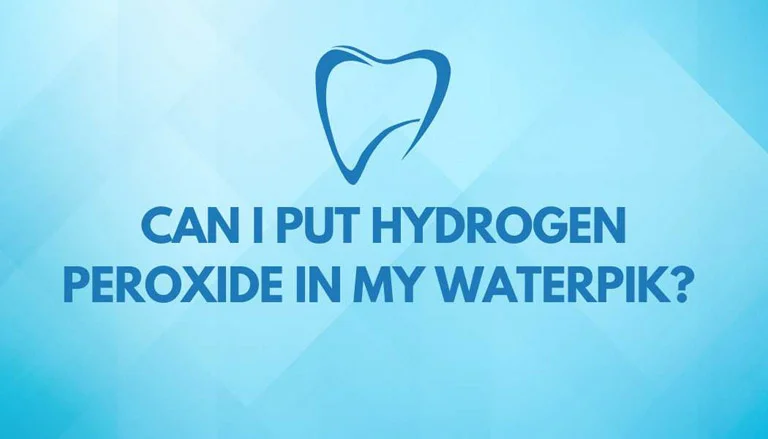Can I put hydrogen peroxide in my Waterpik? Hydrogen peroxide can be used in your Waterpik for its potential antibacterial properties and teeth-whitening effects.
At a concentration of 3%, hydrogen peroxide is considered safe for oral use, but proper dilution is essential to prevent irritation and sensitivity. If you experience discomfort, discontinue use and consult a dental professional. If you’re hesitant about using hydrogen peroxide, consider alternative solutions such as plain water or mouthwash recommended by your dentist.
Waterpik Benefits for Oral Health
Waterpiks are user-friendly and can be particularly appealing to those who find traditional flossing cumbersome. Waterpiks utilize a pulsating stream of water to dislodge and flush away food particles, bacteria, and plaque from between teeth and along the gumline.
- Comprehensive Plaque Removal
- Gentle Gum Stimulation
- Ideal for Braces and Dental Work
- Minimized Gum Bleeding
- Ideal for Individuals with Limited Dexterity
Maintaining the effectiveness and longevity of your water flosser requires a cautious approach to the liquids you use. Essential oils, iodine, and saline solutions, while having potential benefits in other contexts, should not be added to your water flosser due to the risk of staining or damaging the device.
Due to their convenience and effectiveness, individuals use Waterpiks consistently as part of their oral hygiene routine, contributing to improved overall dental health. However, it’s important to remember that while Waterpiks provide unique advantages, they should not replace brushing with fluoride toothpaste or regular dental check-ups.
From Dilution to Benefits: Can I Put Hydrogen Peroxide in My Waterpik?
If you’re considering adding mouthwash or other solutions, ensure that you dilute them as recommended by the manufacturer or dental professional to prevent potential irritation. Pay attention to any signs of sensitivity or discomfort after using added solutions.
Discontinue use if you experience adverse reactions and consult your dentist. Using hydrogen peroxide in your Waterpik may require more frequent maintenance and cleaning to prevent buildup and residue.
One of the primary benefits of using hydrogen peroxide in a Waterpik is that it can reach complex regions. Gingivitis prevention and treatment, and tooth whitening, are some of the health advantages.
Gingivitis is treated by regularly cleaning the gums with a liquid that kills the microorganisms that trigger the condition.
Can I Put Hydrogen Peroxide In My Waterpik?
If you decide to use hydrogen peroxide in your Waterpik, it’s essential to dilute it properly. The typical concentration of hydrogen peroxide found in stores is 3%. To dilute, mix equal parts of 3% hydrogen peroxide with water. Avoid using higher concentrations, as they can be harsh on your oral tissues.
- While hydrogen peroxide has demonstrated benefits, improper use or excessive concentration can pose risks to your gums and overall oral health.
- Hydrogen peroxide in high concentrations can lead to gum irritation, causing discomfort and sensitivity.
- High concentrations of hydrogen peroxide can weaken tooth enamel over time, increasing the risk of dental decay and sensitivity.
- When eaten in excess, hydrogen peroxide can cause severe side effects such as stomach burning, nausea, and vomiting.
- Hydrogen peroxide can weaken dental enamel if used for too long, too regularly, or in excessive amounts.
Why Should You Use Hydrogen Peroxide
- Hydrogen peroxide’s antibacterial nature can help reduce bacteria in the mouth and contribute to better oral hygiene.
- Diluted hydrogen peroxide may assist in gradual teeth whitening over time.
- Hydrogen peroxide in a Waterpik can be used to treat a sore throat. A fungal infection is one of the reasons for sore throat.
- Rinsing with hydrogen peroxide can help relieve symptoms while also minimizing irritation caused by bacteria.
- When gargled or used in a Waterpik, hydrogen peroxide produces oxygen, which kills germs that cause plaque – a sticky coating that builds on the surface of your teeth.
- If you have mouth ulcers, using hydrogen peroxide in your Waterpik may help.
Wrap up
Can I put hydrogen peroxide in my Waterpik? You may use it but in moderation and keeping in mind its effects on your teeth. While some people may consider using hydrogen peroxide in their Waterpik, it’s important to exercise caution and follow guidelines to ensure your safety and oral health.
Adhere to the manufacturer’s recommendations regarding suitable liquids for your water flosser. Consult your dentist or dental hygienist before introducing new agents into your Waterpik routine.
FAQ
Warm water alone suffices according to many researchers. However, you can Add a small amount of mouthwash to your Waterpik water.
Before using hydrogen peroxide in your oral care routine, consult your dentist or dental hygienist. If you choose to use hydrogen peroxide for oral care, it’s crucial to dilute it properly. Limit your use of hydrogen peroxide as a mouth rinse or oral care agent. Overusing it, even in a diluted form, can still lead to potential side effects.
It is safe to use if used in moderation. You need to dilute the hydrogen peroxide and use a limited amount. Prolonged exposure to undiluted hydrogen peroxide harms gum tissues, potentially leading to inflammation and damage.
Adding a small amount of mouthwash to your Water Flosser can offer benefits beyond traditional water flossing. Mouthwash gives a refreshing sensation and combats bad breath ultimately leading towards improved oral freshness. Solutions designed to prevent or treat gum disease can be added to your Water Flosser for targeted care.
Patients should never use essential oils, iodine, or saline solutions in their water flossers since these liquids might discolor or harm the flosser.

